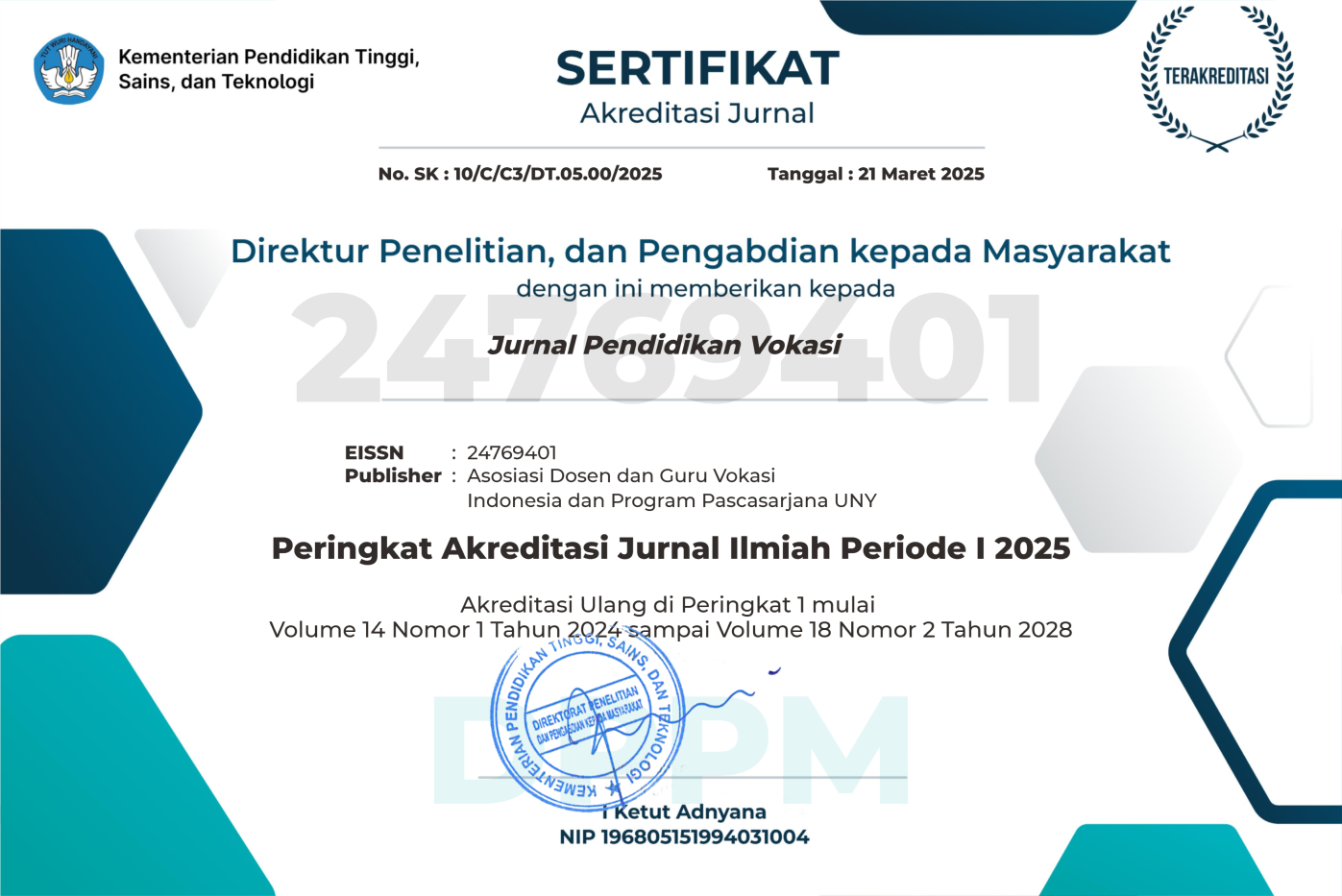The effectiveness of family welfare movement program in slums
DOI:
https://doi.org/10.21831/jpv.v10i2.31976Keywords:
PKK, family welfare, slums, weak economyAbstract
References
Aiga, H., & Umenai, T. (2002). Impact of improvement of water supply on household economy in a squatter area of Manila. Social Science & Medicine, 55(4), 627–641. https://doi.org/10.1016/S0277-9536(01)00192-7
Azwar, S. (2012). Psikologi test dan pengukuran. Pustaka Pelajar.
Badan Koordinasi Survey dan Pemetaan Nasional (Bakosurtanal). (2001). Peta rupa bumi digital Indonesia. Badan Koordinasi Survey dan Pemetaan Nasional (Bakosurtanal).
Baker, J., & Watanabe, M. (2017). Unlocking the Philippines' urbanization potential. World Bank Blogs. https://blogs.worldbank.org/eastasiapacific/unlocking-the-philippines-urbanization-potential
Bocquier, P., Beguy, D., Zulu, E. M., Muindi, K., Konseiga, A., & Yé, Y. (2011). Do migrant children face greater health hazards in slum settlements? Evidence from Nairobi, Kenya. Journal of Urban Health, 88(S2), 266–281. https://doi.org/10.1007/s11524-010-9497-6
Braveman, P., & Gottlieb, L. (2014). The social determinants of health: It's time to consider the causes of the causes. Public Health Reports, 129(1_suppl2), 19–31. https://doi.org/10.1177/00333549141291S206
Chetty, R., Stepner, M., Abraham, S., Lin, S., Scuderi, B., Turner, N., Bergeron, A., & Cutler, D. (2016). The association between income and life expectancy in the United States, 2001-2014. JAMA, 315(16), 1750–1766. https://doi.org/10.1001/jama.2016.4226
Cities Alliance. (2011). Slum upgrading. Citiesalliance.Org. https://www.citiesalliance.org/about-slum-upgrading
Clasen, T. F., Roberts, I. G., Rabie, T., Schmidt, W.-P., & Cairncross, S. (2006). Interventions to improve water quality for preventing diarrhoea. In T. F. Clasen (Ed.), Cochrane Database of Systematic Reviews. John Wiley & Sons. https://doi.org/10.1002/14651858.CD004794.pub2
Cohen, B. (2006). Urbanization in developing countries: Current trends, future projections, and key challenges for sustainability. Technology in Society, 28(1–2), 63–80. https://doi.org/10.1016/j.techsoc.2005.10.005
Duflo, E. (2012). Women empowerment and economic development. Journal of Economic Literature, 50(4), 1051–1079. https://doi.org/10.1257/jel.50.4.1051
Gaur, K., Keshri, K., & Joe, W. (2013). Does living in slums or non-slums influence women's nutritional status? Evidence from Indian mega-cities. Social Science & Medicine, 77, 137–146. https://doi.org/10.1016/j.socscimed.2012.11.017
Gruebner, O., Khan, M. M. H., Lautenbach, S., Mí¼ller, D., Kraemer, A., Lakes, T., & Hostert, P. (2011). A spatial epidemiological analysis of self-rated mental health in the slums of Dhaka. International Journal of Health Geographics, 10(1), 36. https://doi.org/10.1186/1476-072X-10-36
Gí¼nther, I., & Harttgen, K. (2012). Deadly cities? Spatial inequalities in mortality in sub-Saharan Africa. Population and Development Review, 38(3), 469–486. http://www.jstor.org/stable/41857401
Hazarika, I. (2010). Women's reproductive health in slum populations in India: Evidence from NFHS-3. Journal of Urban Health, 87(2), 264–277. https://doi.org/10.1007/s11524-009-9421-0
Islam, M. A., Rahman, M. M., & Mahalanabis, D. (1994). Maternal and socioeconomic factors and the risk of severe malnutrition in a child: A case-control study. European Journal of Clinical Nutrition, 48(6), 416–424. http://europepmc.org/article/med/7925224
Jones, P. (2017). Formalizing the informal: Understanding the position of informal settlements and slums in sustainable urbanization policies and strategies in Bandung, Indonesia. Sustainability, 9(8), 1436. https://doi.org/10.3390/su9081436
Kulasekaran, R. (2012). Influence of mothers"² chronic energy deficiency on the nutritional status of preschool children in Empowered Action Group states in India. International Journal of Nutrition, Pharmacology, Neurological Diseases, 2(3), 198–209. https://doi.org/10.4103/2231-0738.99471
Kuswardinah, A. (2019). Ilmu kesejahteraan keluarga (5th ed.). Unnes Press.
Kuswardinah, A., & Kariada, N. (2010). Pemberdayaan anggota PKK menuju peningkatan kualitas hidup keluarga masyarakat Deliksari Kodya Semarang. Lembaga Penelitian dan Pengabdian Masyarakat Universitas Negeri Semarang.
Kuswardinah, A., Setyaningsih, D. N., & Saptariana, S. (2019). Meningkatkan pemahaman etiket sehari-hari melalui pendidikan bagi pengurus dan anggota PKK Kelurahan Sukorejo Kodya Semarang. Teknobuga: Jurnal Teknologi Busana Dan Boga, 7(1), 61–73. https://doi.org/10.15294/teknobuga.v7i1.19554
Lampert, T., & Kuntz, B. (2019). Effect of poverty for health and health behavior of children and adolescents: Results from KiGGS Wave2. Bundesgesundheitsblatt - Gesundheitsforschung - Gesundheitsschutz, 62(10), 1263–1274. https://doi.org/10.1007/s00103-019-03009-6
Montgomery, M. R. (2008). The urban transformation of the developing world. Science, 319(5864), 761–764. https://doi.org/10.1126/science.1153012
Regulation of Semarang City Region No. 14 of 2011 on the arrangement of regional spatial planning in Semarang City in 2011–2031, (2011).
Sclar, E. D., Garau, P., & Carolini, G. (2005). The 21st century health challenge of slums and cities. The Lancet, 365(9462), 901–903. https://doi.org/10.1016/S0140-6736(05)71049-7
Stringhini, S., Sabia, S., Shipley, M., Brunner, E., Nabi, H., Kivimaki, M., & Singh-Manoux, A. (2010). Association of socioeconomic position with health behaviors and mortality. JAMA, 303(12), 1159–1166. https://doi.org/10.1001/jama.2010.297
Suryahadi, A., & Marlina, C. (2018). Understanding metropolitan poverty: The profile of poverty in Jabodetabek area. In D. P. Sarahtika (Ed.), SMERU Working Paper. The SMERU Research Institute. https://www.smeru.or.id/en/content/understanding-metropolitan-poverty-profile-poverty-jabodetabek-area
Tigga, P. L., & Sen, J. (2016). Maternal body mass index is strongly associated with children Z-scores for height and BMI. Journal of Anthropology, 2016, 1–10. https://doi.org/10.1155/2016/6538235
UN-Habitat. (2003). The challenge of slums-global report on human settlements 2003. United Nations Human Settlements Programme.
UN-Habitat. (2010). State of the world's cities 2010-2011: Bridging the urban divide - Overview and key findings. Sustainable Development Goals Knowledge Platform. https://unhabitat.org/state-of-the-worlds-cities-20102011-cities-for-all-bridging-the-urban-divide
United Nations. (2015). The millennium development goals report 2015. United Nations.
Waddington, H., Snilstveit, B., White, H., & Fewtrell, L. (2009). Water, sanitation and hygiene interventions to combat childhood diarrhoea in developing countries. International Initiative for Impact Evaluation, Synthetic(001). https://developmentevidence.3ieimpact.org/search-result-details/systematic-review-repository/water-sanitation-and-hygiene-interventions-to-combat-childhood-diarrhoea-in-developing-countries/9406
Zereyesus, Y. A., Amanor-Boadu, V., Ross, K. L., & Shanoyan, A. (2017). Does women's empowerment in agriculture matter for children's health status? Insights from Northern Ghana. Social Indicators Research, 132(3), 1265–1280. https://doi.org/10.1007/s11205-016-1328-z
Downloads
Published
How to Cite
Issue
Section
Citation Check
License
The authors submitting a manuscript to this journal agree that, if accepted for publication, copyright publishing of the submission shall be assigned to Jurnal Pendidikan Vokasi. However, even though the journal asks for a copyright transfer, the authors retain (or are granted back) significant scholarly rights.
The copyright transfer agreement form can be downloaded here: [JPV Copyright Transfer Agreement Form]
The copyright form should be signed originally and sent to the Editorial Office through email to jpvokasi@uny.ac.id
Jurnal Pendidikan Vokasi by http://journal.uny.ac.id/index.php/jpv is licensed under a Creative Commons Attribution-ShareAlike 4.0 International License.












